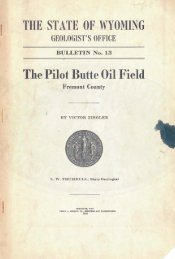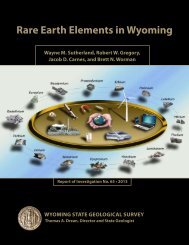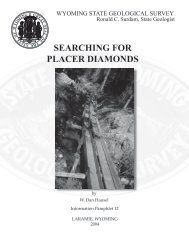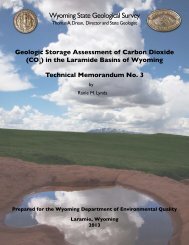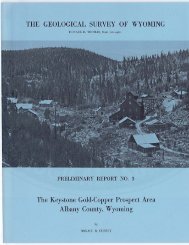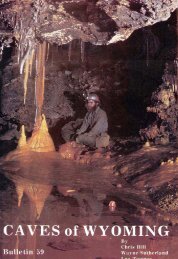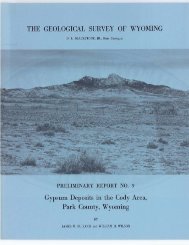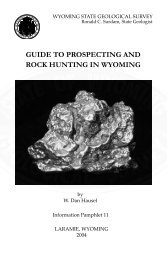The Dinosaurs of Wyoming - Wyoming State Geological Survey ...
The Dinosaurs of Wyoming - Wyoming State Geological Survey ...
The Dinosaurs of Wyoming - Wyoming State Geological Survey ...
You also want an ePaper? Increase the reach of your titles
YUMPU automatically turns print PDFs into web optimized ePapers that Google loves.
CHAPTER X<br />
Evidences <strong>of</strong> Disease and Inju1) Among<br />
the <strong>Dinosaurs</strong><br />
<strong>The</strong> indications <strong>of</strong> pathological conditions among the bones<br />
<strong>of</strong> the ancient dinosaurs are relatively rare, and consist. for<br />
the most part. <strong>of</strong> insignificant disturbances; fractures. abscesses.<br />
arthritides and a single tumor comprising the catalogue<br />
<strong>of</strong> disease and injury among the dinosaurs.<br />
An enormous fractured rib (Figure 12, d) <strong>of</strong> one <strong>of</strong> the<br />
huge amphibious dinosaurs is on exhibition in Field Museum,<br />
FIGURE 9.<br />
Backbone joints, Nos. 17-21, <strong>of</strong> the <strong>Wyoming</strong> whip-tail dinosaur, Diplodocus longuS.<br />
seen from the right side, showing fusion <strong>of</strong> the joints by a diseased process called<br />
Spondylitis deformans. <strong>The</strong> series <strong>of</strong> bones pictured has an actual length <strong>of</strong> about five<br />
feet. <strong>The</strong> opening seen in the lesion to the left allows an examination <strong>of</strong> the articular<br />
surfaces which are unaffected by disease. A fortunate fracture through the second<br />
lesion from the left shows the entire ends <strong>of</strong> the bones to be healthy. <strong>The</strong> disease forms<br />
a ring-like growth by the ossification <strong>of</strong> the longitudinal ligaments through disease. At<br />
this point the thirty-foot tail <strong>of</strong> the reptile reached the ground, and Osborn thought the<br />
conjoined bones indicated a "resting point" in the tail when the animal reared up on<br />
its hind legs like a kangaroo. Specimen in the American Museum <strong>of</strong> Natural History,<br />
X. I-IS.-After Osborn.<br />
associated with an unhealed fracture <strong>of</strong> an adjoining rib. This<br />
was in the "thunder lizard," the largest <strong>of</strong> the amphibious<br />
dinosaurs. <strong>The</strong> injury could only have come from a blow<br />
by another dinosaur, or by a falling rock or tree.<br />
Fractured limb bones are rare among dinosaurs, chiefly<br />
because <strong>of</strong> the size <strong>of</strong> the bones. An upper arm bone <strong>of</strong> a<br />
horned dinosaur found in Canada by Barnum Brown had suffered<br />
an oblique fracture which became badly infected. A pus<br />
sinus was formed and the bone did not heal. This is the first<br />
indication <strong>of</strong> a subperiosteal abscess among the dinosaurs. and<br />
is clear evidence <strong>of</strong> the presence <strong>of</strong> infective germs.<br />
43<br />
:




